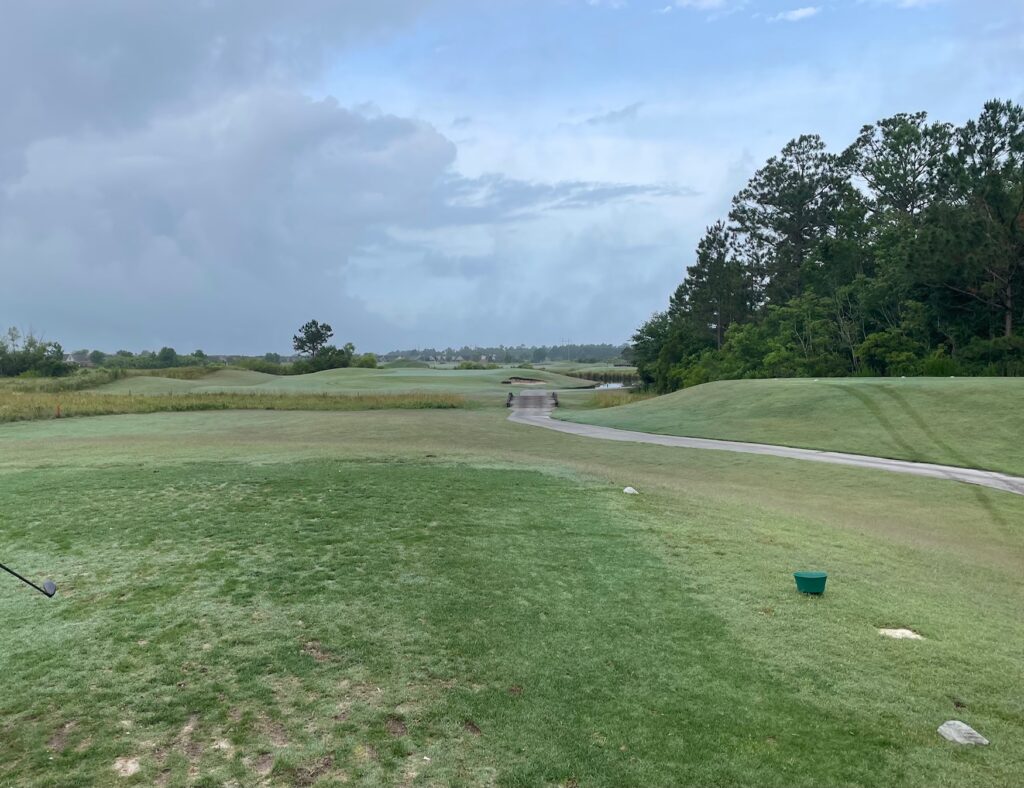All golfers are seeking consistency!
We all believe if we could just find that go to stock shot that draws or fades on demand, we could play fun, enjoyable and even competitive golf.
Whether a golfer is a 15 handicap or a 5 handicap, they all want that comfort over a shot to know where the ball is going to start and what way it will curve.
We are firm believers that the two most important parts of any swing are the swing path and the club face and the relationship at impact and throughout the swing.
The golfer that is able to control the club face and have a quality swing path can play the consistent golf that we all seek.
What is the best swing path for a driver?
For a driver, the golfer will want an inside out swing path. This could be anywhere from 2 degrees to 5 degrees in to out. This helps the golf have a shallow approach to the ball and hit a controlled draw or fade based on club face and the alignment prior to the shot.
What is an inside out swing path?
A swing path that is considered inside out is moving to the right as it strikes the golf ball and then starts moving left shortly thereafter. Another way to visualize an inside out swing is if a circle was painted on the ground through the ball and through your feet. The golfer that has an inside out swing path will strike the ball on the backside of the circle, before moving left after the strike.
Struggle with an outside to in swing path? Check out the post below:
Outside to In With Path? (Cure It!)

How to understand what your swing path with your driver measures?
There are two quality options for a golfer:
- Option 1: Purchase a launch monitor like a Skytrak or Mevo+ (Two affordable options)
- Option 2: Understand ball flight laws and read your ball flight
Option 1
The most accurate way to get a reading on what your swing is doing is through a launch monitor. Of course, not everyone can afford a Trackman or another high end launch monitor, but there are some affordable options in today’s golf market. The two most common are the Skytrak and the Mevo+. On both of these devices you can see your shot tracer and get the following data after every shot:
- Swing Path
- Spin Axis
- Club and Ball Speed
- Carry and Total Distance
- Launch Angle
This provides you with the ability to have data after every shot for immediate feedback. We know to maximize learning, timely feedback is essential to the growth process.
Pros and Cons of an Open Club Face
Option 2
A second option that doesn’t cost any money is to have an understanding of the ball flight laws. Here is a brief overview with some key items.
Ball Flight Laws: A Basic Overview
- The ball will start in the relative direction of where the clubface is aiming at impact.
- The ball will then curve away from the swing path.
- So if your clubface is left of the swing path at impact, the ball will curve left. If your clubface is right of the swing path at impact, the ball will curve right.
Here is how you can ready your ball flight through several examples:
- Shot: Ball starts right and draws left (Push Draw). This is a clubface that is slightly open at impact with a path further to the right.
- Shot: Ball starts right and fades right (Push Fade). This is a clubface that is slightly open at impact with a path that is left of the clubface.
- Shot: Ball starts left and fades right (Pull Fade). This is a clubface that is slightly closed at impact with a path that is left of the clubface.
- Shot: Ball starts left and draws left (Pull Draw). This is a clubface that is slightly closed at impact with a path that is right of the clubface.
Some key items to point out:
- If the curve is extreme, there is a large gap between your clubface and your swing path.
- If the curve is soft, there is a small gap between your clubface and your swing path.
- Arguably the most difficult shot to hit in golf is the straight shot. This requires a perfectly square clubface with a 0 degree path.
Our recommendation is to develop a stock draw or a stock fade that will have a path that is right or left of the club face by 1-2 degrees.
Stock Shot Drill
- At the driving range, set up an alignment stick about 6-8 yards in front of you, straight down your target line.
- If you have a second alignment stick, set the stick 3-4 feet right of the first stick (for a draw) or left of the first stick (for a fade).
- Complete your initial assessment see how many times out of 10 you can start the ball to the right or left of your target. Pick one side and measure your game at this point.
- The goal is to eventually get 7 out of 10 shots to start to the correct side and draw back towards the target.
We believe the swing path is only 2nd in importance to the clubface in the golf swing.
Check out this post: What is the most important part of the golf swing?

More About the Ideal Swing Path
As you experiment with the different swing paths and club face alignments, you will notice that if there is too big of an extreme between the two you will fight a slice or a hook. Or maybe even the overdraw for some advanced golfers. The key is to keep your swing path and your club face within 1-2 degrees of each other.
The slight fade with the driver is becoming a common shot on the PGA Tour, but oftentimes these shots are still hit with an inside to out swing path. Here is how this is done:
- The golfer aims left for the final destination target for the golf ball.
- They swing a path that is 1-2 degrees inside to out.
- Their clubface is then 3-4 degrees open.
- As a result, they hit a shot that starts right and curves right, leading to a controlled fade that helps them hit more fairways without losing distance.
However, there are still plenty of golfers that hit a draw with most of the clubs in the bag. The draw shot is oftentimes easier to control with the height of the shot and can mean some extra distance for some golfers.
Next Steps: What is the best swing path for a driver?
Head to the driving range and chart your next 10-20 shots with the driver. Take note of the following:
- Start direction of the shot
- Curve of the shot
- Feels that you had in your swing
- Determine what your shot pattern is
If you would like to hit a fade, check out this post: Fade shot in golf (what, how, why and when)
If you would like to hit a draw, check out this post: Draw shot in golf (complete overview)
Finally, if you would really like to dive into this swing path journey, don’t forget to check out your options in the a variety of affordable launch monitors in today’s golf market. I went with the Skytrak and close to 1000 rounds later on my golf simulator, I am playing at a scratch level after playing most of my golf in the upper 70’s for years.
The Skytrak can be used as part of a golf simulator or simply as a device you take with you to the range, the course, or hit shots into a net with.
Check out Skytrak Package Here!

My Secret To Golf Improvement
Let’s face it, in order to get really good at golf, we must practice frequently. About four years ago, I made the leap and invested in a golf simulator build for my garage. I went with a SkyTrak Launch Monitor and the TGC software and can now play over 100,000 courses including Augusta, Pebble Beach, Bethpage Black, Whistling Straits. St. Andrews and many other of the top 100 courses in the world.
This golf simulator setup, which is more affordable that you might imagine, has been a game changer. I can now play golf everyday of the year regardless of rain, snow, cold weather or time of day. I can practice or play rounds of golf. I can stand in the 11th fairway at Augusta and with the auto-rewind feature I am able to practice my approach shots from various differences.
It is worth checking out through Rain or Shine Golf as they offer some incredible packages along with financing offers that are difficult to beat.
Some direct links to Rain or Shine Golf for pricing and financing:
Take Action – What You Can Do Today to Get Better
What does this mean for you? I believe in the following recipe to get better:
1 – Improve your motion in the golf swing by identifying a golf instructor. Here are some options:
Here is a list of golf instructors that we have reviewed:
2 – Train to swing faster and improve your swing speed. Here are some options:
Looking to gain more Speed and Distance in your swing. Two Options:
3 – Understand course strategy and work to break through your next barrier. Here is a series on breaking through:
We have provided guides on how to break 100, 90, 80 and 70. Check out more below, if interested.
4 – Practice Frequently
Did you know that I build a golf simulator in my garage and have played over 500 rounds of golf on my SkyTrak system? It has been a game changer and one worth checking out. Here are some of my other posts on golf simulators frequently asked questions:
- Is a Golf Simulator Worth It?
- How to Build a Golf Simulator?
- What is the Best Golf Simulator?
- Golf Simulator Accessories?
- How to Build a Golf Simulator for under $7000
- Top 11 Reasons to Buy a SkyTrak
- How to Build a Golf Simulator for Under $1000
- Why Build A Golf Simulator?
- What Space is Needed?
- Can A Golf Simulator Improve My Game?
- How Much Does A Golf Simulator Cost?
- Don’t Forget to Check out our 15 best golf swings of all time.
I am an amateur golfer on a journey to get better, enjoy the game as often as possible and share my passion and knowledge with others. I have coached high school golfers at a high level and have a great passion for the game and want to give back. I enjoy learning about the golf swing and am currently studying to be a certified professional golf instructor. Join me in our journey to get better everyday. Thank you for reading!

